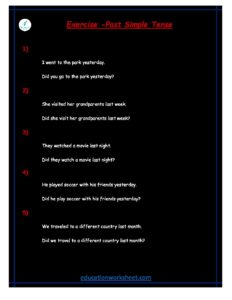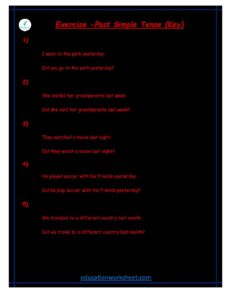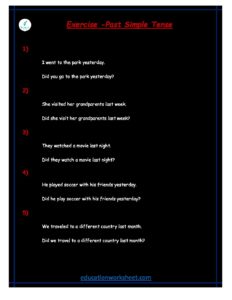12: changing Past Simple Tense to positive and interrogative worksheets
changing Past Simple Tense to positive and interrogative
The Past Simple tense is a fundamental aspect of English grammar used to describe actions or events that occurred at a specific point in the past. While constructing sentences in the Past Simple tense, it’s essential to know how to create both positive and interrogative forms. In this comprehensive guide, we will delve into the intricacies of transforming sentences from Past Simple positive to interrogative forms, exploring various examples and scenarios.
Positive Past Simple Tense:

Before delving into the conversion to interrogative sentences, let’s briefly review how to construct positive sentences in the Past Simple tense. In the Past Simple tense, you typically use the base form of the verb for regular verbs, while irregular verbs have specific past forms. The basic structure of a positive Past Simple sentence is as follows:
[Subject] + [Verb (Past Simple form)] + [Complement]
Here’s an example:
- She visited her grandparents last weekend.
In this example, “She” is the subject, “visited” is the Past Simple form of the verb “visit,” and “her grandparents last weekend” is the complement that provides additional information about the action.
changing Past Simple Tense to positive and interrogative worksheets
Interrogative Past Simple Tense:

To change a positive Past Simple sentence into an interrogative one, you need to invert the word order of the subject and verb. Additionally, you should use auxiliary verbs to form questions. The basic structure of an interrogative Past Simple sentence is as follows:
[Verb (Past Simple form)] + [Subject] + [Complement] + ?
Let’s take our previous example and convert it into an interrogative sentence:
- Did she visit her grandparents last weekend?
In this interrogative form, “Did” is the auxiliary verb used to indicate the question in the Past Simple tense. The verb “visit” returns to its base form because the auxiliary verb “Did” takes the role of indicating the past action.
Key Rules and Tips:
Now that we’ve covered the basics, here are some key rules and tips for changing Past Simple tense from positive to interrogative:
- Use “Did” as an Auxiliary Verb: In most cases, you will use “Did” as the auxiliary verb to form questions in the Past Simple tense. “Did” is used for all subjects (I, you, he, she, it, we, they).
- Did + Subject + Base Form of the Verb + Complement + ?
- Keep the Verb in Base Form: When constructing interrogative sentences, the main verb always returns to its base form, regardless of whether it’s regular or irregular. The auxiliary verb “Did” carries the past tense information.
- Use Question Words: Interrogative sentences often include question words like who, what, where, when, why, and how. These words can be placed at the beginning of the sentence to seek specific information.
- When did she visit her grandparents last weekend?
- Why did they leave the party early?
- Inverted Word Order: Always remember to invert the word order of the subject and verb when forming questions.
Now, let’s explore various examples and scenarios to illustrate how to change positive Past Simple sentences into interrogative ones.
Regular Verbs:
- Positive: He played football yesterday. Interrogative: Did he play football yesterday?
- Positive: She cooked dinner last night. Interrogative: Did she cook dinner last night?
Irregular Verbs:
- Positive: They bought a new car last month. Interrogative: Did they buy a new car last month?
- Positive: He ate a delicious pizza for lunch. Interrogative: Did he eat a delicious pizza for lunch?
Questions with Question Words:
- Positive: She visited her friend last week. Interrogative: Who did she visit last week?
- Positive: They went to the beach on Saturday. Interrogative: Where did they go on Saturday?
Negative Past Simple Sentences:

- Positive: She read the book. Negative: She didn’t read the book.
changing Past Simple Tense to positive and interrogative Enhance grammar skills with our interactive worksheets on changing Past Simple Tense to positive and interrogative forms. Practice transforming sentences and master English language structure effortlessly. Perfect for learners of all levels seeking to improve their language proficiency.
changing Past Simple Tense to positive and interrogative worksheets

